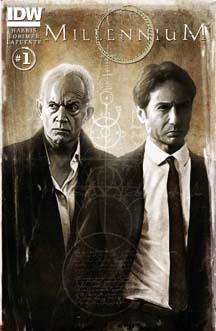While “The X-Files” was spun off into novels as far back as 1994 and into comics in 1995, its sister series, “Millennium” (1996-99), didn’t transition to another medium until 2015, 16 years after it left the airwaves. The fact that it’s written by Joe Harris, who also meticulously pens the “X-Files” title, makes the five-issue “Millennium” series – a chronological tie-in with “X-Files” Season 10 — about as good as it can be. But it has two things working against it that it can’t quite overcome.
First, the TV series is a bit of a narrative mess. It’s often been said that each of the three seasons seems like a different show; the first was overseen by Chris Carter, the second by Glen Morgan and James Wong, and the third by Carter’s hand-picked guys. Carter even admitted to not having watched all of Season 2 when he planned Season 3. Broadly speaking, the crux of “Millennium” is that Frank Black – a brooding Fox Mulder-type, plus visions but minus a sense of humor (except for occasional super-dark humor) – works with the Millennium Group to stop the coming apocalypse … until he finds out that the group itself aims to bring about the apocalypse.
Harris resurrects the conflict in 2015, with the new wrinkle that Frank’s daughter, Jordan, has now grown into a young woman and joined the Millennium Group – which still wants to recruit Frank, and which Frank still doesn’t trust.
Oddly, “Millennium’s” conflict is in another way rather straightforward. In the standalone episodes, Frank takes on serial killers or other examples of human evil. In the wider mythology, his nemesis is Lucy Butler (Sarah-Jane Redmond), who is literally the Devil, or “Legion,” as she prefers to be called in this comic series. (At least, Frank thinks she’s the Devil, not just an “ordinary” demon, and I trust his judgement in these matters.)
Second, “Millennium” is more driven by mood than “The X-Files” is. “The X-Files” can smoothly transfer to other media because it is story-driven enough. But “Millennium’s” beauty comes from Mark Snow’s music (I still think the theme song is the most gorgeous of any TV intro), Lance Henriksen’s grim performance and the dark Vancouver-area cinematography befitting the dark themes and stories. The show marinates in the nature of evil, making a viewer dwell in the darkness with Frank, rather than ever coming to any strong conclusions – narrative or thematic.
Harris had brought Frank back into the “X-Files”/”Millennium” fold in Issue 17 of “X-Files” Season 10, basically so Frank and Mulder could cross paths again and say hi. This miniseries starts with Mulder – who shares the Issue 1 cover with Frank – in a courtroom arguing against the release of Monte Propps, a vintage “X-Files” villain who never actually appeared on the show. Mulder wrote a monograph on Propps that led to the serial killer’s arrest in 1988 and made the agent a profiling legend within the FBI (until he squandered his good name by obsessing over the X-Files). Before they meet in person, Scully knows Mulder by reputation from the Propps case.

Artist Colin Lorimer and colorist Joana Lafuente ably mimic “Millennium’s” mood in comic-book form, even though it’s a near-impossible task for the reasons mentioned above. Harris’ story has a disconnected feel that kind of works along those lines, too. Essentially, Propps is just one of a series of people Lucy possesses and dispatches until her showdown with Frank, Mulder and Jordan in Issue 5. That’s a pretty tasty idea, and it makes me wonder if Lucy possessed Propps going all the way back to 1988.
Another tasty idea is the suggestion that the Millennium group planted bombs in the World Trade Center towers at the turn of Y2K that helped the buildings collapse in the 9/11 attacks 21 months later. While it’s a brave concept, the fact that it isn’t addressed after Issue 1 is a bit of an evasion by Harris.
Jordan comes onto the scene in Issue 3, and this is where the story would’ve gained a significant added punch if it were a TV series. Brittany Tiplady hasn’t done much acting since playing the role of Jordan as a child, so it would be fascinating to see her return as a young adult. As it stands, I didn’t totally grasp that this woman was Jordan, at least not visually. It doesn’t help that Frank and Jordan are (relatively) happy when we last see them in 1999 – in the “X-Files” Season 7 episode “Millennium” — and now they are estranged.
Even though this miniseries is largely just a reminder of the old plot points, it manages to dredge up enough story that it exits with more intriguing threads than when it entered: Specifically, that Jordan is now dealing with full-fledged visions of human-perpetrated horrors just like Frank did. But perhaps because Frank tried to shelter her from her powers for so long, she might not deal with it as well as Frank has. Throw in her involvement with the shifty Millennium Group, and Jordan becomes vulnerable to evil even as she ostensibly fights it. Also, it’s not entirely clear how Jordan defeats Lucy. Does she absorb some of her powers? Does she absorb some of her evil? I’d pick up that continuing story – in comic or TV form.
Considering that it’s a three-season TV series that’s over a decade old, we should probably just be thrilled that we got the five issues of “Millennium” in 2015. Still, with Harris and Carter still overseeing “The X-Files” at IDW, and with Mulder and Frank and their investigations more closely intertwined than in the TV days, it’s possible we could get even more “Millennium” (or at least appearances of Frank and Jordan in “The X-Files”) somewhere down the road.

